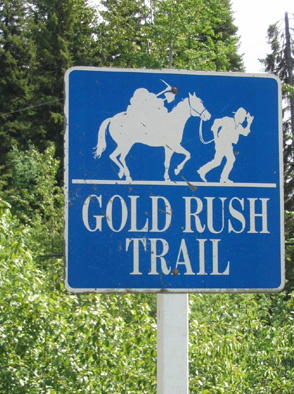
MURDER, MAYHEM
AND MYSTERY
ON THE CARIBOO GOLD RUSH TRAIL
Story and Photos by Margaret Deefholts

|
I am travelling with ghosts. Their earthly lives ended perhaps fifty years, or even over a century ago. But their shadows lie across my pathway today. They were ruffians, hustlers, gamblers, and adventurers. Some were unlettered, others were gentlemen investors. But all of them had one thing in common: a lust for gold. Their trail lies through the history of British Columbia; my trail follows in the outline of their footprints. Where does the story begin? Well, perhaps with Donald McLean, a chief trader of the Hudson's Bay Company. He'd been thunderstruck when one of the members of a local Indian band handed him 800 ounces of gold dust which had been dredged out of the upper reaches of the Fraser River. McLean sent this to the Company's trading post in Fort Langley, who then forwarded it on to the mint in San Francisco for conversion into coin. A miner, James Moore, was at a fireman's meeting in San Francisco in February 1858 when he got wind of the packet en-route to the mint. Galvanized into action, Moore rounded up a foursome of prospectors and lit out for the Fraser River forthwith. A month later, Moore and his group had paused for a meal in the vicinity of Yale. One of his party, T.H. Hill, noticed shiny flecks in the moss covered rocks, and proceeded to pan around a sandbar, (now known as Hill's Bar) discovering in a matter of minutes one of the richest gold bearing sites on the Fraser—a find which would eventually yield two million dollars in placer gold or, in today's money, roughly thirty-five million dollars. “Gold Discovered on Fraser's River!”screamed the headlines in the San Francisco newspapers, and the frenzy was on. Over 30,000 prospectors, some from of the now defunct California gold fields, others from Europe and Australia, jammed the queues clamouring for a miners licences from the Gold Commissioner's Office in Victoria. Hudson's Bay trading post at Fort Langley raked in $1,500 a day as swarms of men stocked up on provisions, clothing, and tools. The prospectors then surged along the Fraser in dugout canoes, rusty tugs, and roughly lashed rafts. Those few who could afford it travelled on paddle-wheelers or hired pack mules, but many trudged on foot from Mission and Hope along rugged trails up into the Fraser Canyon. Yale mushroomed overnight into a seedy frontier-type town with gambling saloons, bordellos, and cheap boarding houses. Drunken brawls were commonplace—but when serious violence broke out between the Americans and the native Indians, Governor James Douglas rushed to declare British Columbia a Crown colony, subject to British civil and criminal law. Enter Judge Matthew Baillie Begbie. A imposing 6'5", Begbie was a larger than life character, both literally and figuratively. Although history has saddled him with the appellation "Hanging Judge", Begbie, in actual fact handed down the death penalty in relatively few instances. Despite his acerbic tongue and formidable temper, he earned a reputation for meting out swift and fair justice. At Yale, Begbie ruled in favour of the Indian band, tamped down the rambunctious American element and, with the help of the military arm of the Royal Engineers and a constabulary force, he restored civil order to the town. Apart from the ghosts of history, I am also travelling
with a group of flesh and blood companions. Today, as our driver and guide,
Brent Rutherford of Ramblin' Roads Tours, approaches Yale, the
Fraser River is running high and Hill's Bar is submerged. But off the
Trans-Canada highway and the roar of logging trucks, and beyond the rumble
of goods Yale was the cork in the bottle as far as river traffic
was concerned. North We board the Hell's Gate Airtram, swing on cables
across the seething river and, on dismounting, I discover anotherwisp
of the past: a pigtailed Chinese cook named Ah Foo Yu whose claim to immortality
is that his culinary expertise was so prized by a company of railroad
workers that pandemonium broke out when he was abducted by a rival camp.
Worse still, his stove refused Our route winds through Lytton, and then up via Spencer's Bridge, Ashcroft, Cache Creek and Clinton. Lytton's main claim to fame is that it is the hottest spot in B.C., and today in early June, at 32 degrees centigrade, it lives up to its reputation. Beyond Lytton the earth turns ochre and the hills are pimpled with cactus. The landscape has a strange, eerie beauty: desolate and wild for a few miles and then, as we swing into the town of Ashcroft, the sagebrush gives way to homes and ranches. At the Ashcroft Museum, I find myself in a sepia world surrounded by images of the weather-beaten faces of pioneers, homesteaders, and transient miners; of mule train operators, and stage-coach drivers. |